Tip-Tow Project
The Tip-Tow project, MX-1016, a contract with Republic Aviation, was one of a number of experiments undertaken during the late 1940s and into the 1950s. The object of the experiments was to find some method of increasing the notoriously short range of the first generation of jets to enable them to accompany the piston-engine bombers which enjoyed up to three times the range of the jets. Other experiments included the XF-85 Goblin, intended to be carried in one of the bomb bays of a B-36, the RF-84K FICON slung by trapeze under a B-36 (which was operational for about a year), the Tom-Tom using RF-84F and B-36 in a scheme similar to Tip-Tow. The other, and ultimately successful experiments, were the drogue-and-probe and flying-boom refueling methods, both of which have been standard procedure for some sixty years.
The Tip-Tow project consisted of two Republic F-84D Thunderjets and a B-29 which were modified to enable the F-84s to wing-couple to the B-29. The Thunderjets modified for the experiment were EF-84D-1-RE 48-641 and 48-661; the mother ship was ETB-29A-60-BN 44-62093. 48-641 was the left hand F-84, piloted by Major John Davis; 48-661 was the right hand F-84, piloted by C.E. "Bud" Anderson of the P-51D "Old Crow" fame.
There were many preliminary flights leading up to the most successful with both Thunderjets coupled to the B-29 and all using manual pilot control. That flight, on 20 October, 1950, lasted 2hr 40min. Based upon that success, the decision was made to proceed with a system of electronic feedback flight control. The modifications were accomplished by 1953, and several test flights were made to test the electronic connections. At the last flight, the right hand F-84D was successfully coupled and towed, but no electrical connections were made with the B-29, so that F-84 uncoupled. The left hand Thunderjet successfully coupled, electrical connection was established, and the automatic flight control system was activated. The EF-84D immediately flipped up and over onto the B-29 resulting in both aircraft crashing with all crew members killed. The project was immediately terminated.
I built a model of Tip-Tow in 48th by kitbashing two Tamiya F-84G kits shortened 15" in scale and scratch building the respective right and left wing-tip coupling parts. I modified a Monogram B-29 by scratch building the wing-tip coupling parts to carry the Thunderjets. Appropriate flight crew is modeled for the three aircraft. The decals were created using PhotoShop and printed with an Alps printer. Square brass tubing spans the inside of the B-29 wings and square brass tubes in the F-84 wings insert into the tubes in the B-29 wings. I added 12v electric motors to the B-29 model. A friend built the stand for me and I added a photo gotten from a land survey company to represent the Long Island farmland over which the flights were conducted.
This link has a photo of the Tip-Tow Project taken on 20 October 1950. Note that the photo incorrectly identifies it as "Tom Tom" rather than Tip-Tow. https://en.wikipedia.org/wiki/File:Boeing_B-29_TomTom.jpg
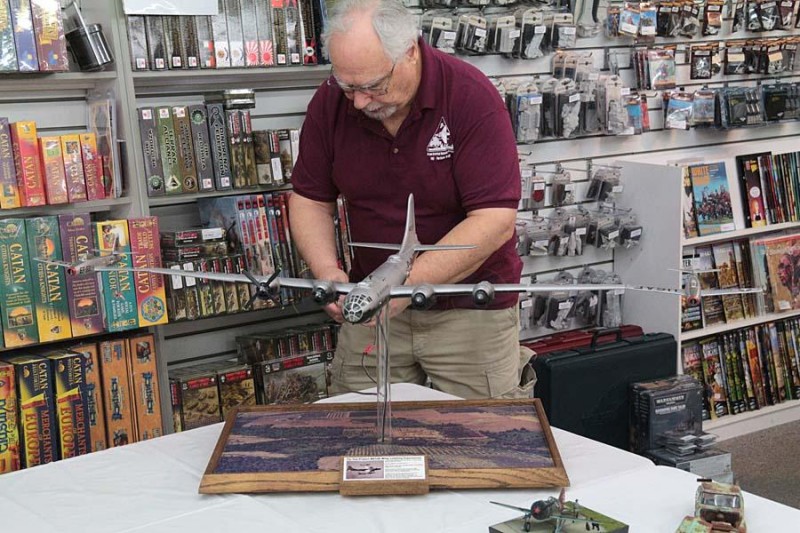
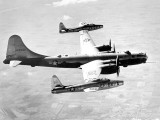
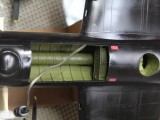
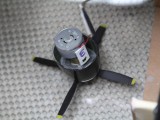
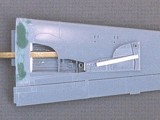
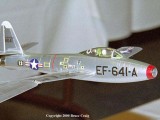
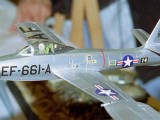
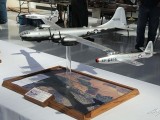
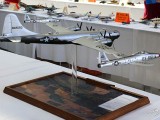
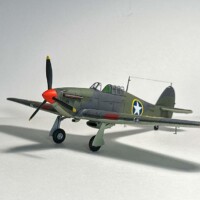
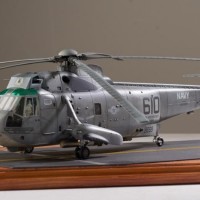

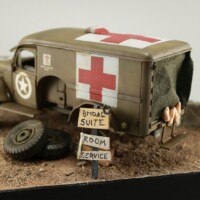
A unique build. Great skill set, with an imaginative display.
I had no idea this had existed. Thanks for the interesting text.
Great build and paintjob too.
Very interesting story with an unfortunate ending, but, it makes for an eye catching model.
That's the most unusual thing I've ever heard of, nice as well as interesting build. So where do you store this monster?
Tom, I donated it to a museum that agreed to place it on exhibit. Unfortunately, the future of that museum recently became iffy (no, not referring to Evergreen Aviation Museum which, notwithstanding rumors perpetrated by reporters who don't investigate with due diligence, is in good standing for the long run), so they returned the model to me a couple weeks ago. It currently languishes in its shipping crate, where it will stay for the next couple of months pending other display possibilities. Prior to going to the museum, it rested on top of our filing cabinets.
Awesome to see this as a model. Well done. The same wingtip latch-on was also done with the B. 36. Now that would look spectacular!
Actually, the wingtip system used on Tom Tom was quite different than that used on Tip-Tow. Tom Tom RFs had to throttle back and the connection was a sort of "alligator jaw" mechanism on the B-36 that clamped down when the RFs backed into the connection. On Tip-Tow, a ram with a socket extended several feet out and the T-jets flew forward to connect with the socket. The ram then retracted into the B-29 wing and locked the fighter in place. The lock held the T-jet in to pitch but not roll. An interesting result was the ailerons caused a wing-warping motion, so the pilots learned to use the elevators to control roll when connected. Pretty amazing piloting.
I'd seen footage of that project before, but this is the first time I've seen it attempted as a model. Come to think of it, I don't recall ever seeing the Goblin "experiement" modeled, either. Quite an undertaking, Bruce...kudos, my friend.
One more thing...I assume that's you in the photo?
After re-reading your narrative, I didn't realize that Bud Anderson took part in that flight. I've read his book, but don't recall him mentioning that...very interesting.
Superior build, very unique!
Wow! How to take a large model and turn it into an imposing table monster! I like the coupling technique you've devised. Great for transportation. Awesome job on an unusual subject.
Hello Bruce, never heard of this remarkable story.
Very interesting, and will see if I can get some more info on this subject.
Your models look great. Wha a time and effort went into this project.
Bruce,
Remarkably done. This is a very impressive model of a time in history. I'm in the process of going back to the articles I've missed. I very much enjoy looking at your work. Your skill and imagination is awesome.